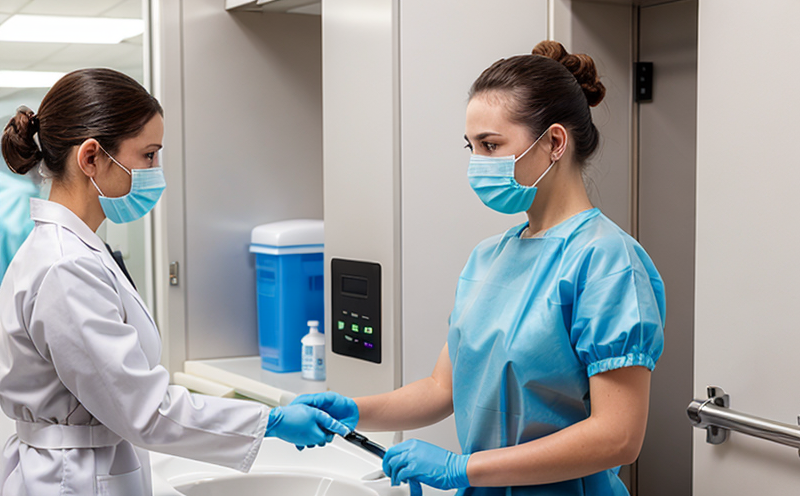Evaluation of antimicrobial finishes on home textile products
The evaluation of antimicrobial finishes on home textile products is a critical service that ensures consumer safety and product efficacy. In the weaving sector, home textiles such as bed linens, towels, bathrobes, and decorative fabrics are increasingly demanded for their hygienic properties. Antimicrobial finishes help in reducing microbial growth, thereby enhancing the hygiene of these textiles.
The antimicrobial performance is typically evaluated using standardized test methods that assess the effectiveness of the finish against specific microorganisms such as bacteria (e.g., Staphylococcus aureus, E. coli) and fungi. The testing process involves exposing treated samples to these organisms in controlled laboratory conditions, followed by rigorous analysis.
The primary test method used is ISO 20743:2018, which provides a procedure for determining the antimicrobial activity of finishes on textiles. This standard specifies the exposure time and temperature, as well as the methods for evaluating the effectiveness of the finish in inhibiting microbial growth. Compliance with this standard ensures that the product meets international hygiene requirements.
For thorough evaluation, samples are prepared by cutting them into standardized pieces. These specimens undergo immersion testing, where they are exposed to a known concentration of microorganisms for a set duration. After incubation, the reduction in viable counts is measured using colony-forming unit (CFU) analysis or other microbiological techniques.
The test results provide quantitative data on the antimicrobial efficacy, which can be expressed as an inhibition zone diameter or percentage reduction in microbial population. This information is invaluable for quality managers and R&D engineers who need to ensure that their products meet regulatory standards and consumer expectations.
In addition to standard methods, there are specialized tests aimed at evaluating the durability of antimicrobial finishes under real-world conditions. These include accelerated aging tests and washing durability assessments. For instance, ISO 17609:2018 provides a method for assessing the resistance of antimicrobial finishes against mechanical abrasion.
Home textile products are often exposed to harsh environmental conditions during use, which can degrade the antimicrobial properties over time. Therefore, it is essential to assess the durability of these finishes under various stressors such as washing cycles and exposure to sunlight. Compliance with standards like ISO 17609 ensures that the product maintains its hygiene performance throughout its lifecycle.
The service also involves detailed reporting of test results, which includes not only quantitative data but also qualitative observations about the appearance and texture changes in the treated samples. This comprehensive approach ensures a thorough understanding of the antimicrobial finish's performance and longevity.
Benefits
Evaluating antimicrobial finishes on home textile products offers several benefits that enhance product quality and consumer safety:
- Enhanced hygiene: Products with effective antimicrobial finishes contribute to a cleaner living environment, reducing the risk of microbial infections.
- Increased durability: The test ensures that the finish remains effective even after multiple washings or exposure to sunlight, maintaining product performance over time.
- Regulatory compliance: Compliance with international standards like ISO 20743 and ISO 17609 helps manufacturers meet legal requirements and gain consumer trust.
- Competitive advantage: Brands that offer hygienic products are more attractive to consumers, providing a competitive edge in the market.
- Improved reputation: Consistent quality and efficacy build a positive brand image among customers.
The service also helps in identifying potential issues early in the product development stage, allowing for corrective actions before mass production. This proactive approach ensures that only high-quality products reach the market, enhancing overall customer satisfaction.
Why Choose This Test
Selecting a reliable laboratory to perform antimicrobial finish evaluations is crucial for ensuring accurate and consistent results. Our team of experts uses state-of-the-art equipment and follows international standards meticulously to deliver precise test outcomes. Here are some reasons why you should choose us:
- Comprehensive expertise: Our professionals have extensive experience in textile testing, enabling them to provide detailed insights into the performance of antimicrobial finishes.
- Accurate and reliable results: We use advanced analytical techniques to ensure that our test results are accurate and consistent with international standards.
- Customized solutions: We offer tailored services to meet the specific needs of each client, ensuring that the tests align perfectly with their product requirements.
- Cost-effective: By providing efficient testing processes, we help clients minimize costs without compromising on quality.
- Fast turnaround time: Our streamlined processes ensure that you receive your test results quickly, allowing for timely decision-making and product launches.
- Confidentiality: We maintain the strictest confidentiality regarding client information and data to protect their intellectual property.
Choosing our laboratory not only ensures compliance with international standards but also enhances the overall quality of your home textile products, providing a safer and more hygienic living environment for consumers.
Use Cases and Application Examples
- Bed linens: Antimicrobial finishes can be applied to sheets, pillowcases, and duvet covers to reduce bacterial growth during sleep.
- Towels: By treating bath towels with antimicrobials, they stay cleaner after use and are less likely to harbor harmful bacteria.
- Bathrobes: Antimicrobial finishes on robes help maintain hygiene after frequent use by reducing the risk of skin infections.
- Duvet covers: Duvets can be treated with antimicrobial finishes to reduce dust mites and other allergens, making them safer for people with allergies.
- Vinyl flooring: While not a textile per se, vinyl floors can be treated with antimicrobials to prevent mold growth in humid areas.
In addition to home textiles, these finishes are also used in other sectors like healthcare and hospitality. For instance, hospital bedding and curtains are often treated with antimicrobial finishes to minimize the spread of infectious diseases. Similarly, hotel linens undergo antimicrobial treatment to ensure a hygienic environment for guests.
The use of antimicrobial finishes extends beyond just hygiene; they can also enhance the aesthetic appeal of home textiles by maintaining their appearance over time. For example, towels treated with antimicrobials not only stay cleaner but also retain their color and texture better than untreated alternatives.





